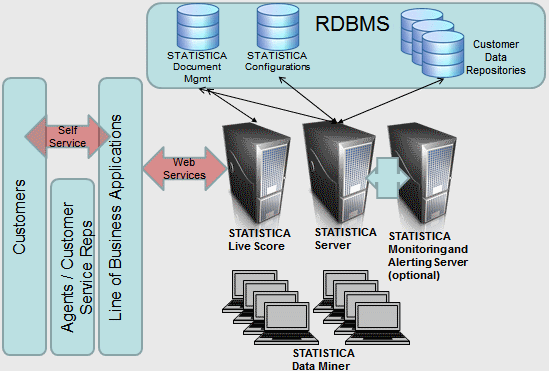StatisticaTM StatisticaTM Live Score
There are many different options in Statistica for deploying models. For scoring data within Statistica data sets in Data Miner, you can use the Rapid Deployment Engine and Predictive Modeling Markup Language (PMML). For scoring data in databases, you can deploy models to the respective database in SQL.
When you want to integrate the models into your lines of business for ongoing scoring transactions to support business decisions, the approach is to use one or more Statistica Live Score Servers. Models are built and validated in Statistica Data Miner or Statistica Text Miner and then output in PMML to the Statistica Live Score Server where they are made available for very efficient, on-demand scoring via Web Services. The fact that they are made available via Web Services is important because it means that various line of business applications integrate with Statistica Live Score through industry-standard, platform-neutral interfaces.
- Statistica Server stores and utilizes definitions of users/permissions, database queries (Data Configurations), Analysis Configurations, Reports, and Server Tasks in its database. Workstation clients can offload time-consuming or resource-intensive model-building to Statistica Server.
- The Statistica Server and Data Miner workstation clients deploy models to Statistica Enterprise Analysis Configurations with the models stored as XML documents (Predictive Modeling Markup Language standard format).
- Statistica Document Management System (SDMS) provides versioning/traceability.
- Line of business applications (e.g., banking/credit cards, insurance, etc.) send XML/SOAP messages to Statistica Live Score Server. Statistica Live Score scores the data using the respective model and sends an XML response back to the calling application.
- Statistica Monitoring and Alerting Server (MAS) monitors the ongoing performance of predictions and provides color-coded (red, yellow, green) status updates and alerts (e.g. emails) based on trends in prediction residuals. For example, MAS can track ongoing residuals of the model predictions via Quality Control Charts (e.g., CuSum charts) and display status updates for each model in Web-based, color-coded Dashboard displays.

